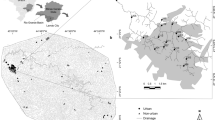Abstract
We tested the hypothesis that urbanization alters stream sediment regimes and homogenizes fish assemblages in 30 sub-basins of the Etowah River. Sediment variables included average particle size (mean phi) of the stream bed, percent fines (<2 mm) in riffles, and baseflow turbidity (NTU). Homogenization was quantified as ratios of endemic to cosmopolitan species richness (Er:Cr) and abundance (Ea:Ca). High NTU and fine stream beds were associated with homogenized assemblages (i.e., lower E:C ratios). Mean phi and NTU were significantly correlated with E:C ratios (r = −0.74 to −0.76) and, when combined using multiple regression, accounted for 73% of the variance in ratios. Stream slope strongly covaried with mean phi (r = −0.92) and percent fines in riffles (r = −0.79), but multiple regression models showed that urbanized sites had finer beds and riffles than predicted by slope alone. Urban land cover was the primary predictor of NTU (r 2 = 0.42) and, combined with slope in multiple regression, explained 51% of the variance in NTU. Our results indicate that stream slope is a background variable predicting particle size and E:C ratios in these streams. Urbanization disrupts these relationships by transforming clear streams with coarse beds into turbid streams with finer beds. These conditions favor cosmopolitan species, ultimately homogenizing fish assemblages. Bed texture was linked to urbanization; however, NTU was the best indicator of urban impacts because it was statistically independent from slope.
Similar content being viewed by others
References
Baer, K. E. & C. M. Pringle, 2000. Special problems of urban river conservation: the encroaching megalopis. In Boon, P. J., B. R. Davis & G. E. Potts (eds), Global Perspectives on River Conservation. John Wiley & Sons Ltd., London, U.K.: 381-398.
Burkhead, N. M. & H. L. Jelks, 2001. Effects of suspended sediment on the reproductive success of the tricolor shiner, a crevice-spawning minnow. Trans. Am. Fish. Soc. 130: 959-968.
Burkhead, N. M., S. J. Walsh, B. J. Freeman & J. D. Williams, 1997. Status and restoration of the Etowah River, an imperiled Southern Appalachian ecosystem. In Benz, G. W. & D. E. Collins (eds), Aquatic Fauna in Peril, the Southeastern Per10 spective. Southeast Aquatic Research Institute, Lenz Design and Communication, Decatur, Georgia: 375-444.
Etnier, D. A. & W. C. Starnes. 1993. The Fishes of Tennessee. The University of Tennessee Press, Knoxville, Tennessee.
Lo, C. P. & X. Yang, 2000. Mapping the dynamics of land use and land cover change in the Atlanta Metropolitan Area using the time sequential Landsat images. Annual Meeting of the American Society of Photogrammetry and Remote Sensing (CD), Bethesda, MD.
McKinney, M. L. & J. L. Lockwood, 1999. Biotic homogenization: a few winners replacing many losers in the next mass extinction. Trends Ecol. Evol. 14: 450-453.
Mettee, M. F., P. E. O'Neil & J. M. Pierson, 1996. Fishes of Alabama and the Mobile Basin. Oxmore House Inc, Birmingham, Alabama.
Paul, M. J. & J. L. Meyer, 2001. Streams in the urban landscape. Ann. Rev. Ecol. Syst. 32: 333-365.
Rahel, F. J. 2000. Homogenization of fish faunas across the United States. Science 288: 854-856.
Scott, M. C. & G. S. Helfman, 2001. Native invasions, homogenization, and the mismeasure of integrity of fish assemblages. Fisheries 26: 6-15.
Seehausen, O., J. J. M. vanAlphen & F. Witte, 1997. Cichlid fish diversity threatened by eutrophication that curbs sexual selection. Science 277: 1808-1811.
Sweka, J. A. & K. J. Hartman, 2001. Influence of turbidity on brook trout reactive distance and foraging success. Trans. Am. Fish. Soc. 130: 138-146.
U.S. Department of Agriculture, 2000. 1997 National Resource Inventory. Percent Change in Developed Land Area. http://www.nhq.nrcs.usda.gov/land/meta/m5010.html.
Warren, M. L., Jr. & 13 others, 2000. Diversity, distribution, and conservation status of the native freshwater fishes of the southern United States. Fisheries 25: 7-31.
Walters D. M., 2002. Influence of geomorphology and urban land cover on fish assemblages in the Etowah River basin, Georgia. Doctoral Dissertation. The University of Georgia, Athens, Georgia.
Waters, T. F. 1997. Sediment in Streams: Sources, Biological Effects, and Control. American Fisheries Society, Bethesda, Maryland.
Wolman, M. G., 1967. A cycle of sedimentation and erosion in urban river channels. Geographiska Annaler 49: 385-395.
Author information
Authors and Affiliations
Rights and permissions
About this article
Cite this article
Walters, D.M., Leigh, D.S. & Bearden, A.B. Urbanization, sedimentation, and the homogenization of fish assemblages in the Etowah River Basin, USA. Hydrobiologia 494, 5–10 (2003). https://doi.org/10.1023/A:1025412804074
Issue Date:
DOI: https://doi.org/10.1023/A:1025412804074




